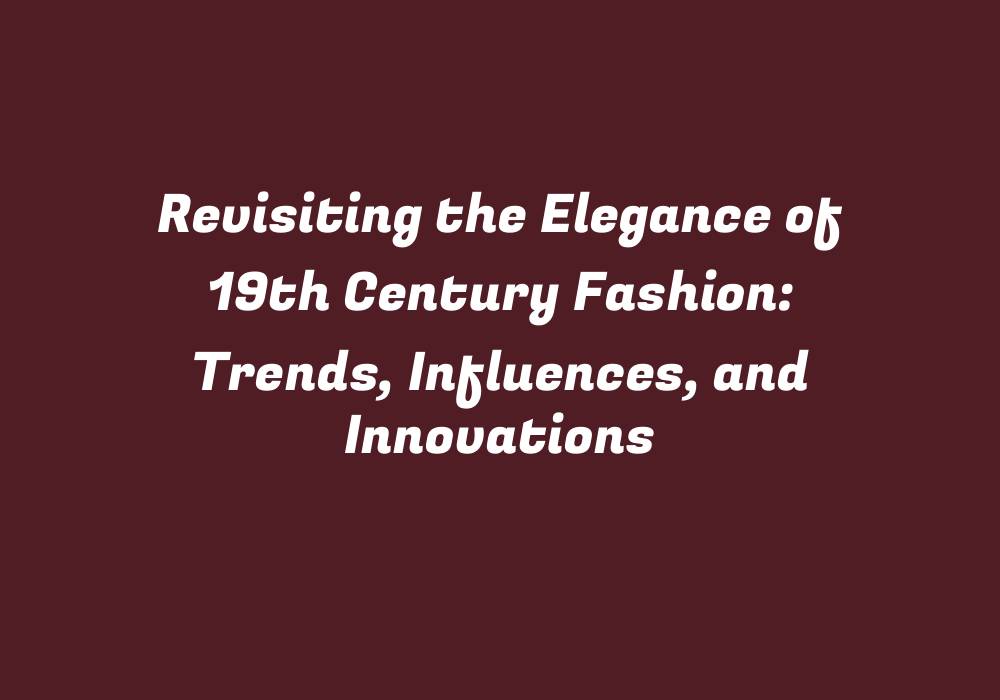Revisiting the Elegance of 19th Century Fashion: Trends, Influences, and Innovations
Introduction
Fashion has a long history that dates back centuries. The 19th century marked an era in which fashion reached new heights. It was characterized by elegance and grandeur, as well as a period of significant cultural influences and innovative advancements. In this article, we will explore the various aspects of 19th-century fashion, including its most prominent trends, key influencers, and the groundbreaking innovations that shaped the fashion landscape during this time.
Trends
Corsetry
The corset was a staple in women’s fashion throughout the 19th century. Initially intended for health reasons, it evolved into an essential part of attire with intricate designs and fine materials. Corsets helped accentuate the female figure by cinching the waistline and enhancing the bust, while also providing support to the upper body. As the Victorian era progressed, the corset’s popularity grew, leading to the introduction of new styles like the “cage” corset and the “bustle.”
Crinolines
The crinoline, a hoop-shaped contraption that women wore beneath their skirts, became synonymous with 19th-century fashion. It was responsible for creating the voluminous silhouettes of the period. Aside from providing support to the skirt’s fullness, it also served as a practical solution by allowing for easier movement and preventing dirt from accumulating on the fabric.
Melodrama
The 19th century witnessed the rise of melodramatic fashions. These extravagant costumes featured dramatic sleeves, elaborate embroidery, intricate beading, and vibrant colors. The aesthetic was inspired by the popular genre of melodrama, which was characterized by heightened emotions, sensational plots, and over-the-top performances.
Influences
Queen Victoria
The reigning monarch during the 19th century, Queen Victoria had a significant impact on fashion trends. As a key style influencer, she was responsible for popularizing certain looks and garments such as the iconic bustle, which became her signature in later years. The queen’s influence extended beyond her own attire, shaping the general aesthetic of the period and inspiring designers to create new styles that catered to her personal tastes.
Cultural Exchange
The 19th century witnessed increased cultural exchange across Europe, especially during the Industrial Revolution when countries experienced rapid technological advancements. As a result, fashion trends were influenced by various international cultures, resulting in eclectic fashions that drew inspiration from diverse sources. The adoption of foreign elements led to a fusion of styles and techniques, contributing to the creation of new and unique fashion movements.
Innovations
During the 19th century, numerous technological advancements in textiles paved the way for new fashion trends and inventions. Cotton became more affordable as mechanical spinning and weaving processes evolved, making it easier to produce fine fabrics such as muslin and organdy. In addition, silk production methods improved with the introduction of silkworm cultivation techniques, enabling mass-market distribution.
The Sewing Machine
The invention of the sewing machine in 1846 by Elias Howe marked a turning point in fashion history. It revolutionized the garment-making process and made it more accessible to the masses, leading to a wider range of styles and designs. As demand for clothing grew, so too did the need for skilled tailors and seamstresses, creating new opportunities for those looking to enter the fashion industry.
Photography
The invention of photography in 1839 by Louis Daguerre provided a means to capture fashion trends and styles in a permanent visual record. Photographers began documenting various aspects of society, including fashions worn by both the aristocracy and ordinary people. This allowed for a more comprehensive understanding of clothing’s influence on culture and daily life during this period.
Conclusion
The 19th century marked a significant era in fashion history, characterized by elegance, cultural exchange, and groundbreaking innovations. From corsets to crinolines and the rise of melodrama, these fashions have left an indelible mark on our understanding of fashion’s evolution over time. The impact of Queen Victoria, international influences, and technological advancements all contributed to shaping this unique chapter in fashion history. Today, we continue to draw inspiration from these remarkable trends and innovations as they serve as a testament to the timeless beauty and ingenuity that defines 19th-century fashion.
